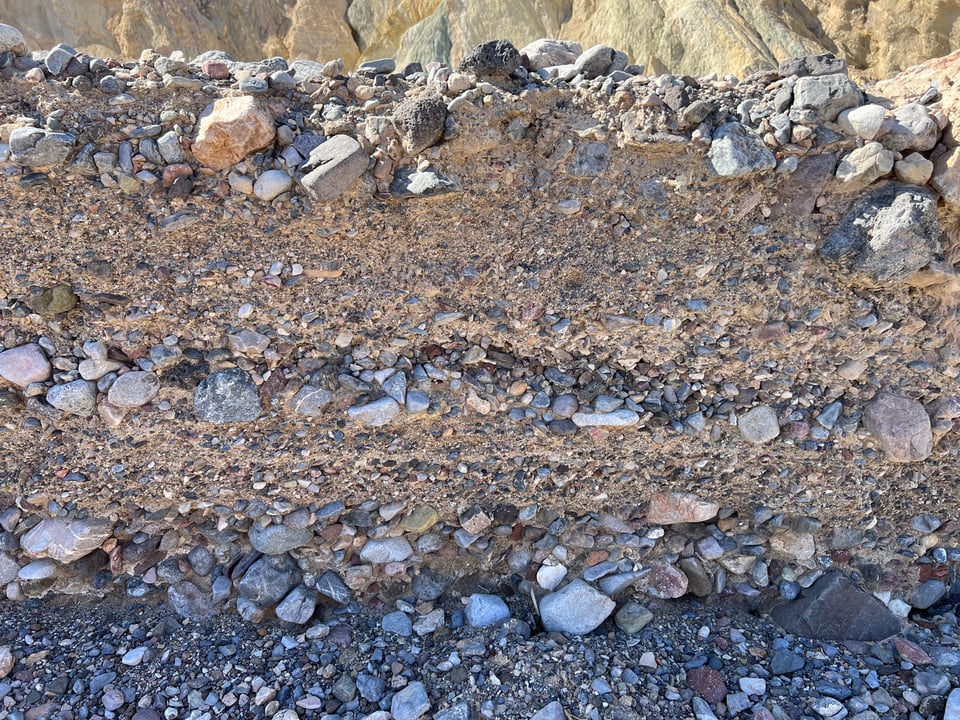Hello my friend! My essays continue to be inspired by my teaching this winter. This week, we visited an alluvial soil and learned about the different kinds of evidence we use to describe and interpret them. I've summarized those ideas here to help you find and observe alluvial soils in your area!
How to identify alluvial soils with three clues
Alluvial soils are some of the most common among us. The term "alluvium" describes sediment and rock that has been transported by flowing water. Usually, this movement occurs within a stream channel, but alluvium can also be transported down hillslopes to create broad alluvial fans (like those in Death Valley!). In either scenario, an alluvial soil is forming in material that has been transported and deposited by running water.
When describing a soil, figuring out the parent material is a critical step towards telling the story of that soil. Soil scientists apply an iterative approach to our observations. We look at the surrounding context in which the soil sits, take a closer look at the physical features present in the soil profile, and then repeat. The more observations we make, the more evidence we gather. Only then can we make a robust determination about a soil's origin.
You are likely to come across alluvial soils in your soil-seeking adventures. You can find them anywhere you find flowing water (past or present) - nearby a river or stream, within a delta or floodplain, on a terrace that sits above a current stream channel, and adjacent to some hillslopes. So, how do we know whether the soil we are observing is, indeed, of alluvial origin? What should we look for? There are three clues that we can use to identify alluvial soils: context clues, rounded rock fragments, and stratified layers. Let's unpack each.
context clues - do you see evidence of flowing water?
Even before we look closely at the features of a soil profile, we can start by thinking about where the soil is in the context of the surrounding landscape. We study the setting of the soil. Is the soil directly adjacent to a flowing water source? Can you see a stream? Do you know that there's a stream somewhere in the area? Sometimes, the vegetation around a stream can obscure our view so we may not be able to see the flowing water directly. With the help of a topographic map, we can find nearby streams and rivers and understand our position in the landscape.

If there's a stream nearby, that's a good clue that you may be observing an alluvial soil. Before we jump to conclusions, we need more evidence! The soil profile holds other clues.
rounded rock fragments - do you see evidence that rocks have been shaped by water?
Rounded rock fragments are characteristic of alluvial soils. Have you ever walked along a river and noticed smooth, rounded rocks? Maybe you've even seen these "river rocks" for sale at a landscaping store. Over time, running water smooths away the craggy, angular edges of rocks. If you notice that most of the rocks in a soil profile (or horizon) are rounded and smooth, that's a good indication that the parent material may be alluvium. In contrast, rocks that have tumbled down a hill by the aid of gravity (we call this colluvium) remain angular and irregular.

stratified layers - do you see varying layers of rocks and sediment of different sizes?
Sediments and rocks that are moved by flowing water are deposited in sequential layers. We can see evidence of this in the soil profile. Adjacent layers are often characterized by different rock or particle sizes. In some horizons, smaller rocks are deposited, whereas other layers are filled with larger rock fragments. This also applies to particle sizes smaller than rocks - some horizons may have finer particles like clays and silts, whereas others may be sandier.
Such variation in particle size arises as a result of the water velocity. It takes more energy to move a large rock or particle. As water slows down, larger particles settle out first, while smaller particles like silt and clay remain suspended in the water column. When the stream floods and deposits sediment, a new layer that holds the signature of the rate of water movement is left behind. Alluvial soils, therefore, often have sorted, or stratified, layers of sediments and rock fragments.

Soils forming in alluvium are diverse in character, shape, and form. Flowing water is everywhere and it is constantly leaving sediment behind. Water also scours away soil material along the banks of rivers. We can often see alluvial soils exposed naturally when we walk alongside streams. As always, remember to be mindful and respectful while exploring soils, document what you find, and share it with others!
Thank you for taking the time to care about soil today. I hope you feel inspired to go out looking for alluvial soils in your area. Invite a friend to join you!
Take care and stay curious,
Yamina
You just read issue #4 of wonder of soil. You can also browse the full archives of this newsletter.
